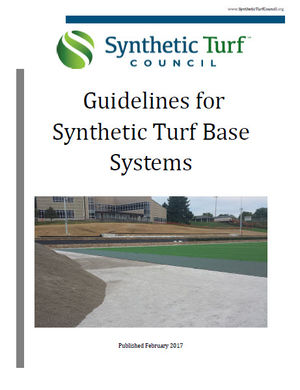 The Synthetic Turf Council (STC), the organization representing the synthetic turf industry, announced the publication of its new Guidelines for Synthetic Turf Base Systems. The voluntary guidelines were developed by STC members, based on their expertise and technical knowledge, and reviewed by other industry experts and organizations, including the American Sports Builders Association (ASBA).
The Synthetic Turf Council (STC), the organization representing the synthetic turf industry, announced the publication of its new Guidelines for Synthetic Turf Base Systems. The voluntary guidelines were developed by STC members, based on their expertise and technical knowledge, and reviewed by other industry experts and organizations, including the American Sports Builders Association (ASBA).
The purpose of these voluntary guidelines is to enable owners, buyers, designers, and contractors of synthetic turf to better understand the range of decisions and variables that comprise the “base” of a synthetic turf installation. The hidden base of a synthetic sports field is equally important as the playing surface. If care is not taken in the design of the base components, the field will suffer over time from maladies caused by poor drainage, uneven site preparation, migration of base rocks, or insufficient slope.
It is not the intention of the STC guidelines to dictate certain methods of designing or constructing a base, since there are countless ways to determine the best base for a given project. Instead they offer concepts and best practices to consider as owners or designers begin a new synthetic field installation.
Some key considerations deal with preparing a base for proper drainage. If a field doesn’t drain away rainwater efficiently, there can be issues with crushed rock base settling, puddling or migration of the infill layer to the downstream areas of a field. Besides initially creating a well-designed water drainage system under the field, drainage pads, which are laid directly under the turf, can be used to help wick water away from the surface.
Some drainage pads are rigid and are designed to move the water without providing any additional resiliency at all. A resilient drainage pad may add shock absorbing properties to the turf system as well as providing a path for water to move away from the turf surface. There are also drainage components that provide water management and shock attenuation. According to the guidelines, these system components can be installed below the synthetic turf infill and carpet, and may replace some layers of the stone base. Field components like ArmaSport® Turf Underlayment Shock Pad, when ordered with the optional drainage perforations, provide both shock attenuation and drainage. Foam underlayment pads are designed to contribute to a safe g-max level for the life of a synthetic turf field, providing another layer of safety for players.
For more information or to download the free guidelines, visit: www.syntheticturfcouncil.org
